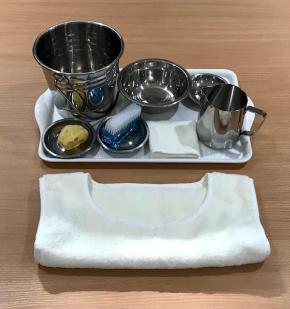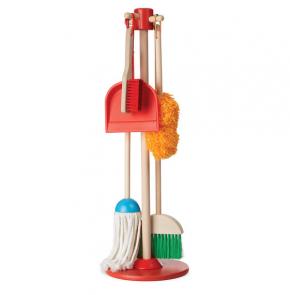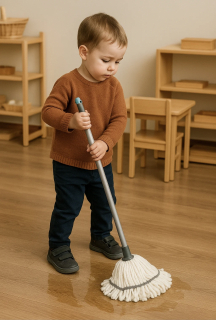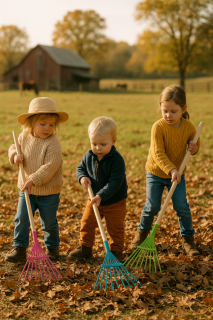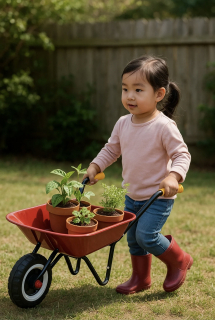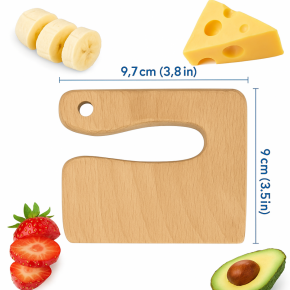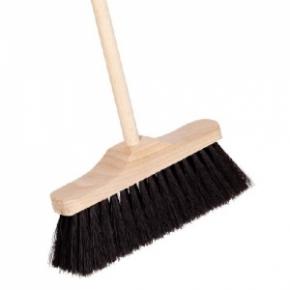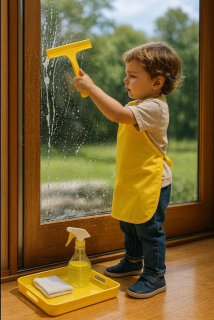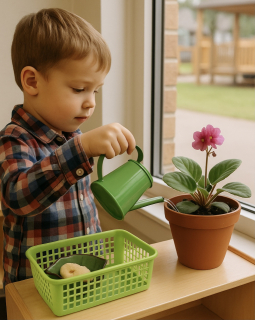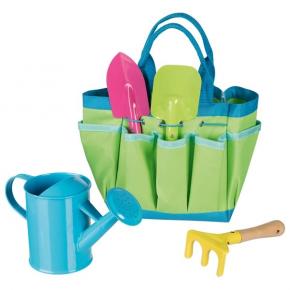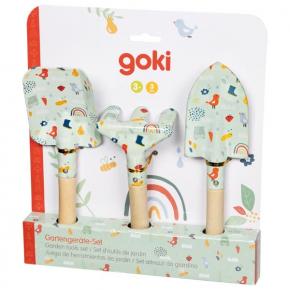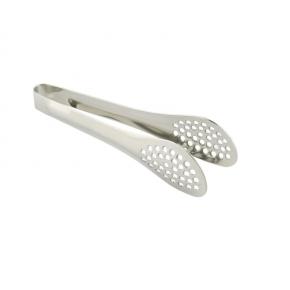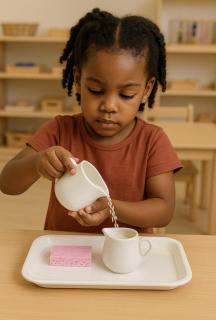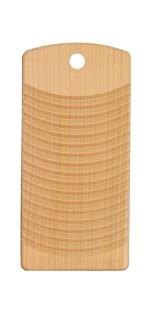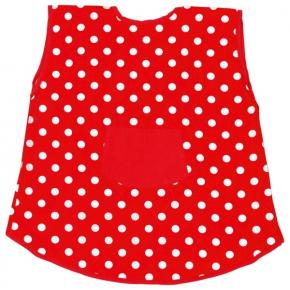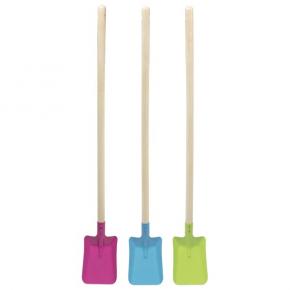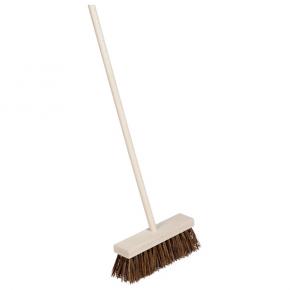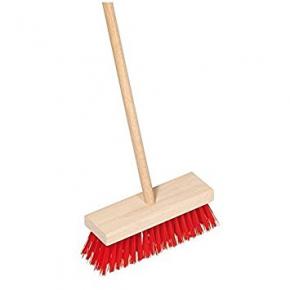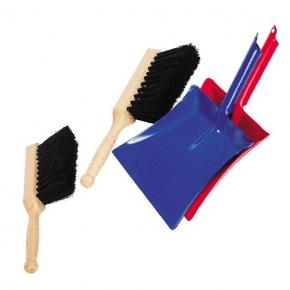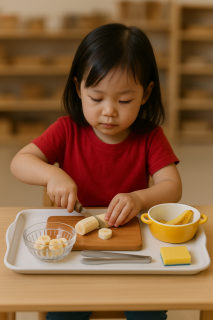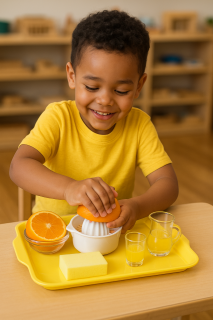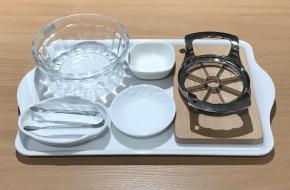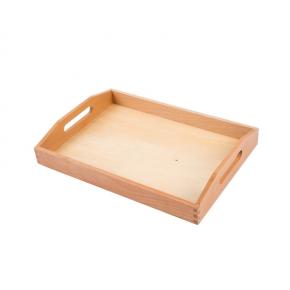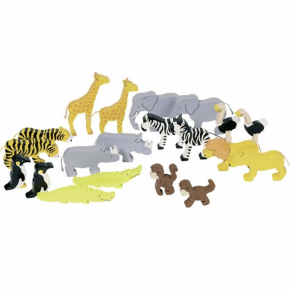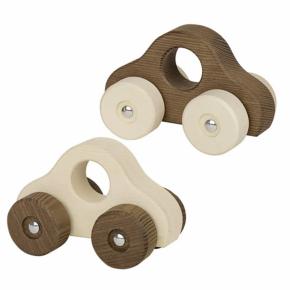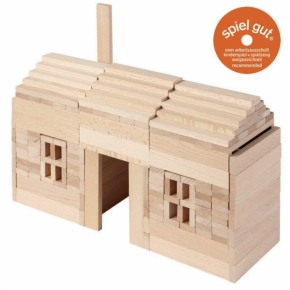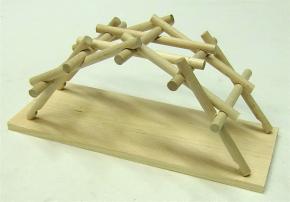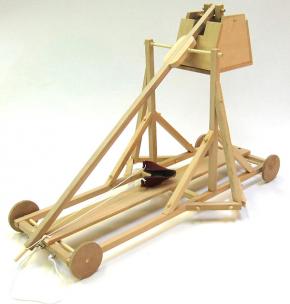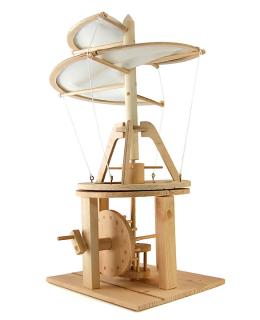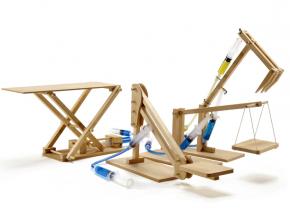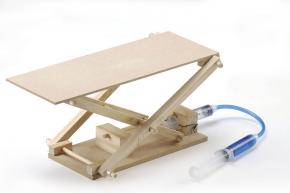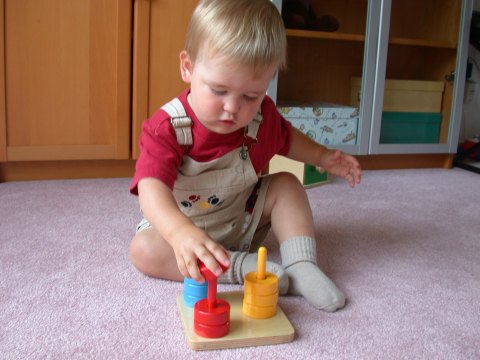
A parent’s guide to meaningful play, inspired by Maria Montessori.
If you’ve ever watched your child quietly concentrate while stacking blocks or pouring water, you’ve seen a moment of deep concentration and discovery — not just play, but learning in motion. This is the Montessori way.
Montessori toys are simple, beautiful, and made for real discovery. They don’t blink or beep. Instead, they help children build real-world skills, through hands-on experiences that feel natural and satisfying.
________________________________________
The Absorbent Mind: Your Child Is Learning All the Time
“The child has a mind able to absorb knowledge. He has the power to teach himself.”
— Maria Montessori, The Absorbent Mind
In the first six years of life, your child experiences what Dr. Montessori called the absorbent mind — a period when children effortlessly soak up language, movement, order, emotion, and even cultural behavior from the world around them.
Toys that support this natural learning — toys that are real, purposeful, and respectful of your child’s stage — aren’t just entertainment. They’re part of how your child builds their mind, body, and sense of self.
________________________________________
Observation: Your Most Powerful Parenting Tool
Montessori education begins with observation — watching your child closely, with patience and curiosity. Dr. Montessori spent years observing children to understand what they truly need.
You can do the same at home. Just sit quietly and observe:
• What draws their attention?
• What do they repeat?
• What frustrates or calms them?
The answers will show you which skills they’re trying to master — and how to support them. You don’t need to plan everything. You just need to follow the child.
“Follow the child, but follow the child as his leader.”
— Maria Montessori
Whether it’s a toddler carrying a watering can, a baby fixates on a thread, or a preschooler trying to read — everything has meaning.
If you slow down and observe, you’ll see: your child is showing you the way. And when you offer Montessori materials with love, clarity, and respect, your child will respond — with focus, joy, and deep learning. Montessori is not about doing more. It’s about noticing more.
It’s about trusting the child — and making space for who they already are becoming.
________________________________________
Understanding Sensitive Periods
How to recognize what your child is working on — and how to help
Dr. Montessori discovered that children go through sensitive periods — short windows of intense interest in specific skills. These don’t last forever, but during these times, your child is especially focused and ready to learn deeply and joyfully.
Here’s what to look for — and how you can support each stage:
________________________________________
Sensitive Period for Order (birth – ~5 years)
What you may notice:
• Your child gets upset if toys are moved or bedtime changes
• Lines up objects or insists on doing things “their way”
• Follows routines and repeats actions in the same sequence
Example:
Your toddler always wants the blue cup at lunch, sits in the same chair, and puts their shoes exactly side by side. If something changes — they get very upset. This isn’t being difficult — it’s their sensitive need for order.
How to support it:
Keep routines steady. Keep toys in the same place on a shelf. Let your child finish the process the way they began — even if it seems unimportant to you.
________________________________________
Sensitive Period for Movement (birth – ~4 years)
What you may notice:
• Climbing on everything
• Repeatedly pouring water, scooping, balancing, twisting
• Practicing the same physical movement again and again
Example:
Your toddler carries a heavy basket from one room to another over and over — with no clear “goal.” They’re not being silly — they’re practicing gross motor control, balance, and coordination.
How to support it:
Provide safe ways to move: carrying, climbing, sweeping, pouring, using push and pull toys. Children at this age also love big, heavy, real objects — like a laundry basket, a stool, or a watering can — because they want to challenge their growing bodies and feel capable.
________________________________________
Sensitive Period for Language (birth – ~6 years)
What you may notice:
• Intense interest in sounds, words, and books
• Baby babbles and imitates tone
• Toddler points to things and listens carefully when you name them
• Repeats words and loves rhymes, songs, and naming games
Example: You sit with your 1-year-old and quietly name objects: “cup,” “spoon,” “apple.” Soon your child begins pointing to them when asked: “Show me the spoon.” Even before they can talk, they are understanding, absorbing, and remembering language.
How to support it: Use the Montessori 3-period lesson — but keep it gentle and simple:
1. Name it: “dog.”
2. Ask: “Show me the dog.”
3. Test (when they’re ready): “What is this?”
In the beginning, just use the first two steps. Children under 2 often can’t say the word, but they can understand and point.
From my own experience:
I started by showing my 1.5 year old son real objects and pictures: I would place two familiar items in front of him and name each one clearly while pointing to it. Then I would ask, “Show me the spoon,” and he would point. Even before he could speak, he could understand and respond. I quickly noticed his interest in this game and decided to try the same 3-period lesson — but now with letters. It was so important that I had cut-out letters, because my young child could perceive each letter as a separate, tangible object. In Montessori, we call this The Movable Alphabet. Instead of naming the letters by their names (“A,” “B,” “C”), I introduced them by their sounds — like /m/, /b/, /s/. At just 1.5 years old, he would listen carefully, remember, and point to the right letter when asked. Very soon he started repeating the sounds, and from there he began reading phonetic 3-letter words. By age 2, he was reading short sentences, short books, and speaking with clarity and joy. This led to a deep love of reading, and by age 4, he was joyfully reading all kinds of books on his own. I also used the 3-period lesson to learn the names of numbers, which were presented as individual tactile objects — just like in my own material: cut-out wooden numerals. All of this happened between the ages of 1.5 and 2. It felt so easy, fun, and engaging for my child — because this is the sensitive period for language development, when children are naturally drawn to sounds, symbols, and words.
________________________________________
Sensitive Period for Small Objects (~1 – 4 years)
What you may notice:
• Fascination with crumbs, bugs, beads, tiny toys
• Uses fingertips to pick up small pieces
• Interested in fitting things into small spaces
Example:
Your child might spend 10 minutes trying to place small coins into a slot or pegs into holes — and repeat it joyfully.
How to support it:
Offer safe small-object work: posting activities, tweezers, sorting trays, small puzzles. These build concentration and fine motor skills.
________________________________________
Sensitive Period for Practical Life (~1.5 – 6 years)
What you may notice:
• Insists on doing things independently: pouring, dressing, cleaning
• Imitates adults doing real tasks
• Enjoys helping in the kitchen or garden
Example:
Your child spills water and rushes to get a cloth — wiping the floor carefully for several minutes. They feel capable, proud, and responsible.
How to support it:
Offer child-sized tools like a pitcher, sponge, or apron. Let them help you with real work: food prep, laundry, watering plants. Children in this sensitive period absolutely love helping with anything “real” — sweeping floors, loading laundry or dishes into machines, wiping tables, planting flowers, washing windows, brushing pets, raking leaves, or even helping to shovel snow. These everyday tasks give them a deep sense of purpose and belonging, while also building coordination, responsibility, and pride.
________________________________________
Sensitive Period for Social Behavior (~2.5 – 6 years)
What you may notice:
• Notices emotions in others
• Begins imitating manners and tone
• Talks about fairness, kindness, and rules
Example:
Your child may say, “We say thank you when someone gives us something,” after watching you. They’re absorbing social codes and grace & courtesy.
How to support it:
Model respectful behavior. Talk about emotions. Practice sharing and turn-taking. Offer language for problem-solving: “You can say, ‘I’m not done with that yet.”
________________________________________
Creating a Montessori-Friendly Space at Home
You don’t need to transform your house into a classroom — just a few thoughtful touches can make your home more supportive of your child’s development:
• Low shelves: Place toys and activities on open wooden shelves at your child’s height. Use wooden trays with handles to define each activity. Rotate materials regularly to keep interest fresh.
• Child-sized furniture: A small table and chair allow your child to work comfortably and independently.
• Hooks and baskets at child-height: For coats, hats, or bags — this gives your child independence in dressing and undressing.
• Accessible wardrobe or shelf: So your child can choose and put away clothes on their own.
• Defined spaces for activities: A small rug or mat shows where work happens and helps build focus.
When everything has its place — and your child can reach it — independence and order naturally follow.
Montessori isn’t about strict control — it’s about offering the right amount of structure to help your child thrive.
Children need freedom to choose, but also the support of a clear, ordered environment. That’s why Montessori spaces offer just a few carefully selected toys (usually 6–8) on low, open shelves.
Too many toys = overwhelm.
Too few = boredom.
Just enough = focus, satisfaction, and independence.
“To assist a child, we must provide him with an environment which will enable him to develop freely.”
— Maria Montessori
When toys are visible, accessible, and returned to the same place, your child learns responsibility, confidence, and peace.
________________________________________
If you’re ready to begin creating a Montessori-inspired home, we offer a curated selection of materials and child-sized furniture in our online shop — perfect for setting up a beautiful, functional space at home.
And if you're looking to go deeper, I personally recommend two books: How to Raise an Amazing Child the Montessori Way by Tim Seldin — full of photos, tips, and real-life examples for every stage. • If you're expecting or have a baby at home, I also highly recommend Montessori from the Start by Paula Polk Lillard and Lynn Lillard Jessen. You can find it here on our website: Montessori from the Start.
Warmly,
Olga Lapteva
Founder, E&O Montessori
________________________________________
.
💬 What Other Parents Are Saying
“We started rotating toys every two weeks — now my son plays with focus instead of dumping everything out.”
— Sarah, mom of a 20-month-old
“The practical life ideas changed our home. My 2-year-old begs to help cook and water the plants now! We started with the suggestions from Tim Seldin’s book, and it truly made everyday moments meaningful.” — Lisa, mom of a toddler
“I started with just one shelf and three activities. My daughter now chooses work and puts it away on her own!”
— Emily, mom of a 2-year-old
“I never realized how much my son wanted to help until I gave him a child-sized broom. Now he sweeps every day — and reminds me when I forget!”
— Natalie, grandmother of a toddler
You can browse our full At Home collection here.

